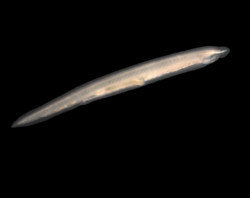Lancelet
| Lancelets | ||||||||
|---|---|---|---|---|---|---|---|---|
 Lancelet (Branchiostoma lanceolatum)
|
||||||||
| Scientific classification | ||||||||
|
||||||||
| Families | ||||||||
|
Asymmetronidae |
The lancelets (subphylum Cephalochordata, traditionally known as amphioxus) are a group of primitive chordates. They are usually found buried in sand in shallow parts of temperate or tropical seas. In Asia, they are harvested commercially for food for humans and domesticated animals. They are an important object of study in zoology as they provide indications about the origins of the vertebrates. Lancelets serve as an intriguing comparison point for tracing how vertebrates have evolved and adapted. Although lancelets split from vertebrates more than 520 million years ago, its genome holds clues about evolution, particularly how vertebrates have employed old genes for new functions.[1]
In the issue of Nature on 19 June 2008, the draft genome sequence of the Florida lancelet (Branchiostoma floridae) was reported.[2]
Contents |
Physical features
Lancelets grow up to about five centimetres long, reaching eight centimetres at the longest. In common with vertebrates, lancelets have a nerve cord running along the back, pharyngeal slits and a tail that runs past the anus. Also like vertebrates, the muscles are arranged in blocks called myomeres. Unlike vertebrates, the dorsal nerve cord is not protected by bone but by a simpler notochord made up of a cylinder of cells that are closely-packed to form a toughened rod. The lancelet notochord, unlike the vertebrate spine, extends into the head. This gives the subphylum its name (cephalo- meaning 'relating to the head'). Lancelets also have oral cirri, thin tentacle-like strands that hang in front of the mouth and act as sensory devices and as a filter for the water passing into the body. The water exits the body via the atriopore.

- brain-like blister
- notochord
- dorsal nerve cord
- post-anal tail
- anus
- food canal
- circulatory system
- atriopore
- overpharynx lacuna
- gill slit
- pharynx
- vestibule
- oral cirri
- mouth opening
- gonads (ovary/testicle)
- light sensor
- nerves
- metapleural fold
- hepatic caecum (liver-like sack)
Taxonomy
The Cephalochordata is traditionally seen as a sister subphylum to the vertebrates, with which it is grouped together into a clade (sometimes called Notochordata) which in turn is the sister group to the simpler still Urochordata. Newer research suggests this may not be the case. The Cephalochordata may be the most basal subphylum of the chordates,[3] while the sister group of the vertebrates may be the urochordates.[2] However, other recent molecular studies (cit. in Benton 2005: 8) place cephalochordates nearer to vertebrates, and "[m]ost authors regard amphioxus as the closest relative of the Vertebrata on the basis of 10–15 [morphological] features that are not seen in tunicates".[4]
The asymmetric nature of juveniles is unique to the cephalochordates and demonstrates (as do certain other features, including the seriated gonads) that lancelets are more derived than would be expected. This is a reminder that the "living fossil" representative of a basal clade has as long an evolutionary history as any other living thing, and thus is more derived than the actual primitive ancestor it otherwise so closely resembles.
The following are the species recognised by ITIS. Other sources, for instance Tudge,[5] show that there might be up to thirty species.
- Family Asymmetronidae
- Genus Asymmetron
- Asymmetron lucayanum
- Asymmetron maldivense
- Genus Epigonichthys
- Genus Asymmetron
- Family Branchiostomidae
- Genus Branchiostoma
- Branchiostoma belcheri
- Branchiostoma californiense
- Branchiostoma capense
- Branchiostoma caribaeum
- Branchiostoma floridae
- Branchiostoma lanceolatum
- Branchiostoma valdiviae
- Branchiostoma virginiae
- Genus Branchiostoma
In music
Folk musician and marine biologist Sam Hinton performed a song written in 1921 by Philip H. Pope about Amphioxus entitled It's a Long Way from Amphioxus. Sung to the tune of "It's a Long Way to Tipperary," the ditty references now-disputed notions about the place of cephalochordates in the chordate evolutionary timeline:
It's a long way from Amphioxus,
It's a long way to us,
It's a long way from Amphioxus
To the meanest human cuss.
It's good-bye, fins and gill-slits,
Welcome, lungs and hair!
It's a long, long way from Amphioxus,
But we all came from there.
References
- ↑ Worm-like Marine Animal Providing Fresh Clues About Human Evolution Newswise, Retrieved on July 8, 2008.
- ↑ 2.0 2.1 Nicholas H. Putnam, et al. (2008). "The amphioxus genome and the evolution of the chordate karyotype". Nature 453 (7198): 1064-1071.
- ↑ Henry Gee (2008). "Evolutionary biology: The amphioxus unleashed". Nature 453: 999-1000.
- ↑ Michael J. Benton (2005). Vertebrate Palaeontology, Third Edition 8. Oxford: Blackwell Publishing. ISBN 0-632-05637-1.
- ↑ Colin Tudge (2000). The Variety of Life. Oxford University Press. ISBN 0198604262.
Links
- Error in the Genealogy of Human
- The Amphioxus Song
- A special issue of Amphioxus Research (I)
- A special issue of Amphioxus Research (II)
- Amphioxus and the T-box gene
- A movie of the amphioxus embryonic development
- American Scientist Online - The Lancelet
- Scripps Scientists Discover Fluorescence in Key Marine Creature
|
||||||||||||||